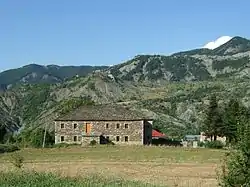Frashër
Frashër (Aromanian: Farshar) is a village and a former municipality in the Gjirokastër County, southern Albania. At the 2015 local government reform it became a subdivision of the municipality Përmet.[1] The population at the 2011 census was 387.[2] The municipal unit consists of the villages Frashër, Zavalan, Ogren-Kostrec, Gostivisht, Miçan, Vërçisht, Kreshovë and Soropull.[3]
Frashër | |
|---|---|
 Museum of brothers Frashëri | |
 Frashër | |
| Coordinates: 40°22′N 20°26′E | |
| Country | |
| County | Gjirokastër |
| Municipality | Përmet |
| Population (2011) | |
| • Municipal unit | 387 |
| Time zone | UTC+1 (CET) |
| • Summer (DST) | UTC+2 (CEST) |
History
The first documented attestation of Frashëri probably comes in the form of an Albanian merchant from Frashër who had traveled to Thessaloniki in 1330.[4] The Frashër area in the Middle Ages was the source of several waves of migrations of Aromanians throughout the southern and central Balkans.[5] Their peculiar variant of Aromanian to this day is called fãrsherot.[6] In 1432 the village was documented as Fracili in the Ottoman defter of the sanjak of Korçë-Përmet. The defter documented six households in Frashër at the time. The next defter to document Frashër is that of 1504. The village had 41 households, 40 of whom were Christian. The heads of households from which the major vëllazëri (brotherhoods) of Frashër would form in the 17th century include Dedë Duka, Dukë Kryeziu, Uk Deda, Gjon Deda, Martin Bardhi, Deskë Gjini, Dedë Gjini, Kozma Shurbi, Kolë Shurbi, Bendo Shurbi, Gjon Gjoni, Llazër Gjoni and others.[7]
In June 1880 the Second Assembly of Frashër was organised by the League of Prizren.[8]
Ottoman Albanian spahis and landowners from nineteenth century Frashër owned estate properties (chiftlik) in parts of the Balkans and in particular the Thessalian plain, until its loss to Greece in 1881 leading to local economic decline and increasing reliance on agriculture.[9]
Notable people
- Dalip Frashëri, 19th-century poet
- Shahin Frashëri, 19th-century poet
- Abdyl Frashëri, Albanian politician
- Naim Frashëri, Albanian poet
- Sami Frashëri, Albanian writer
- Mihal Zallari, chairman of the assembly of Albania, historian and journalist
- Kristo Frashëri, Albanian historian
- Fehim Zavalani, Albanian journalist
- Mehdi Frashëri, Prime Minister of Albania
References
- "Law nr. 115/2014" (PDF). Archived from the original (PDF) on 2015-09-24. Retrieved 2015-06-10.
- "2011 census results" (PDF). Archived from the original (PDF) on 2016-03-04. Retrieved 2015-01-31.
- Greece – Albania Neighbourhood Programme Archived March 27, 2012, at the Wayback Machine
- Frashëri, Kristo (2010). Frashëri, shkëlqimi dhe rrënimi i tij: vështrim i shkurtër. p. 14. ISBN 9789995688097.
- Ioan Caragiani (1929). Studii istorice asupra românilor din Peninsula Balcanică. Litera Internaţional. ISBN 978-973-85856-3-8.
- Mioara Avram; Marius Sala (15 December 2013). Les presentamos la lengua rumana. Universidad de Alicante. pp. 16–. ISBN 978-84-9717-276-9.
- Frashëri 2014, p. 35.
- Pollo, Stefanaq (1983). Historia e Shqipërisë: Vitet 30 të shek. XIX-1912. Akademia e Shkencave e RPS të Shqipërisë, Instituti i Historisë. p. 249.
- Clayer, Nathalie (2007). Aux origines du nationalisme albanais: La naissance d'une nation majoritairement musulmane en Europe [The origins of Albanian nationalism: The birth of a predominantly Muslim nation in Europe]. Paris: Karthala. p. 110. ISBN 9782845868168.CS1 maint: ref=harv (link)
Sources
- Frashëri, Alfred; Frashëri, Neki (2014). Frashëri në historinë e Shqipërisë. Dudaj. ISBN 978-99943-0-051-8.

